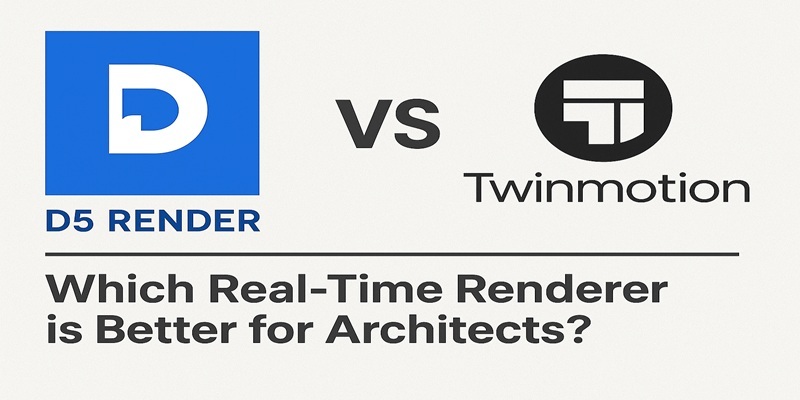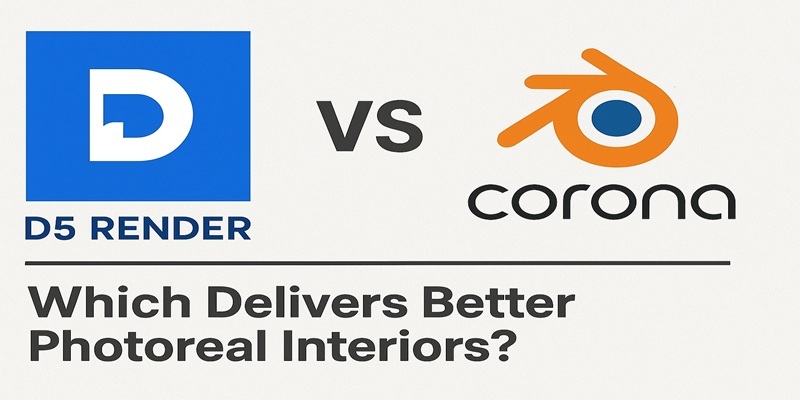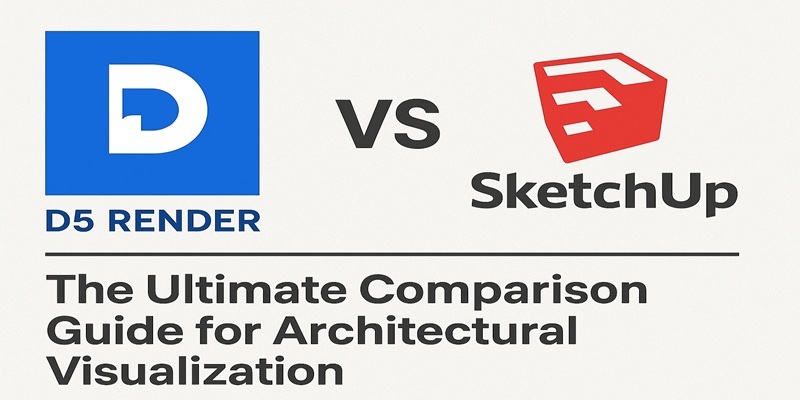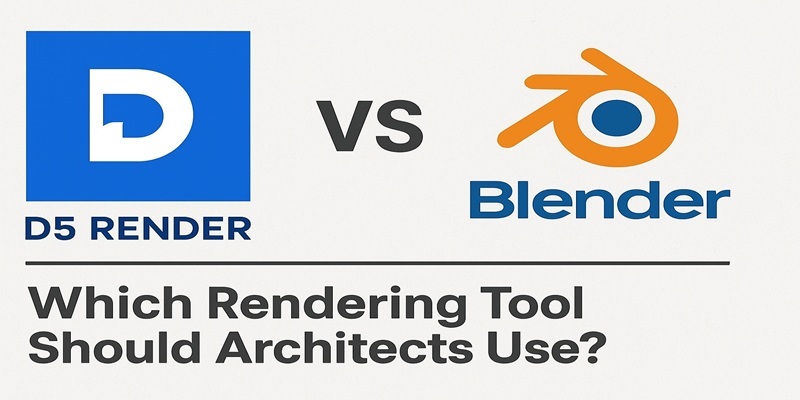
Architectural visualization continues to evolve as new technologies enhance the way designers bring their projects to life. D5 Render and Twinmotion are two of the most widely used 3D rendering tools in the industry today, each offering distinct features that cater to specific project needs.
According to The Insight Partners, the global 3D rendering market is projected to reach USD 11.83 billion by 2030. This growth shows how essential tools like D5 Render vs Twinmotion have become in producing high-quality architectural visualizations.
When comparing real-time rendering architecture in D5 vs Twinmotion, architects need to assess factors such as rendering speed, quality, ease of use, cost, and project scale. Both tools offer unique strengths, but their use cases differ depending on project type and specific design goals.
What is D5 Render?

D5 Render is a real-time rendering engine that prioritizes speed and simplicity, making it ideal for architects who need quick, high-quality visual outputs. Its GPU-based rendering system enables rapid visual feedback, crucial for client presentations and iterative design processes.
Key Features:
- Real-Time Rendering: GPU acceleration for instant updates in fast-paced workflows.
- AI Tools: Automatically enhances lighting, materials, and environments.
- Asset Library: Includes extensive interior, exterior, and landscape assets.
- Live Sync: Real-time connection with CAD tools like SketchUp, Revit, and Rhino.
- User-Friendly Interface: Simple, intuitive, and professional-grade.
As a 3D architectural rendering software, D5 Render is known for its clean output and efficient interface, which makes it one of the best rendering software for architecture professionals focusing on realistic interior scenes.
What is Twinmotion?

Twinmotion is a real-time visualization software renowned for creating immersive and interactive design experiences. Built for architects and urban planners, it excels in large-scale and landscape projects where visualization and interaction are key.
Key Features:
- Real-Time Rendering: Produces photoreal visuals instantly.
- Interactive Walkthroughs: Enables architects to explore projects interactively.
- Large Asset Library: Includes detailed materials for both interior and exterior design.
- Advanced Lighting: Offers realistic shadows, reflections, and weather systems.
- Cross-Platform Support: Works seamlessly across macOS and Windows.
Twinmotion architectural visualization stands out in how it transforms conceptual models into dynamic, lifelike presentations. It’s particularly effective in presenting large-scale environments, offering a high degree of realism and interactivity.
D5 Render vs Twinmotion: Comparison
Both D5 Render vs Twinmotion deliver exceptional results but serve slightly different needs. Below is a comparison of their key differences:
|
Aspect |
D5 Render |
Twinmotion |
|
Rendering Engine |
Real-time GPU-based rendering |
Real-time rendering with high-quality visuals |
|
Ease of Use |
Beginner-friendly interface |
Simple interface, ideal for quick visualizations |
|
Speed |
Extremely fast, real-time rendering |
Quick but slower for larger scenes |
|
Materials & Lighting |
Real-time updates for lighting and materials |
High-quality materials and lighting control |
|
Cost |
Subscription-based, free version available |
Free version with paid professional version |
|
Best For |
Quick, high-quality renders for presentations |
Interactive visualizations for large-scale projects |
This D5 Render vs Twinmotion workflow comparison shows that while both tools are powerful, they cater to different architectural needs and design scales.
a. Architectural Use-Cases
D5 Render is ideal for architects producing high-quality interior and exterior renders under tight deadlines. The real-time rendering architecture in D5 vs Twinmotion gives designers instant feedback, streamlining revisions and communication during client presentations.
Twinmotion excels at real-time, immersive visuals, making it perfect for urban design and large-scale projects. Together, they represent the next generation of 3D rendering tools, providing flexibility and efficiency for different architectural visualization needs.
b. Features

When analyzing the core strengths of D5 Render vs Twinmotion, each software has unique features that support distinct workflows:
D5 Render
- Real-time GPU acceleration ensures rapid visualization.
- AI-assisted features optimize materials and environmental lighting automatically.
- Intuitive tools make it one of the best rendering software for architecture professionals who need fast, reliable results.
Twinmotion
- Strong focus on interactivity and scene immersion.
- Capable of handling complex environmental adjustments and animations.
- Particularly effective for Twinmotion architectural visualization across larger environments.
While both qualify as advanced 3D architectural rendering software, D5 Render emphasizes precision and speed, whereas Twinmotion focuses on creating emotional, experiential design presentations.
c. Pros & Cons
|
Aspect |
D5 Render |
Twinmotion |
|
Pros |
Lightning-fast rendering, user-friendly interface, realistic output |
Immersive experiences, strong environment controls, and interactive walkthroughs |
|
Cons |
Limited scalability for complex projects |
Requires more system resources for large files |
Ultimately, D5 Render vs Twinmotion highlights how both solutions serve different aspects of visualization. D5 Render is best for architects looking for fast, high-quality renders, while Twinmotion is better suited for large, immersive visualizations that require detailed environmental control.
Master D5 Render Along With 8+ Computational Tools
For architects looking to push their design capabilities beyond traditional rendering, Novatr’s Master in Computational Design offers a comprehensive foundation. This hands-on program is built to help architects and designers future-proof their careers. Through expert-led training, you’ll learn how to combine creativity with technology to solve complex design challenges.
Here’s what you’ll learn in detail:
- 5 powerful industry tools, Grasshopper, Rhino 3D, Flux.ai, ComfyUI, and D5 Render.
- Master popular plugins like Paneling Tools, DeCoding Spaces, Anemone, Galapagos, Wallacei, LunchBox, Open Nest, and Horster Animation to create smarter, faster design workflows.
- Understand how to build parametric and generative design workflows used by top global firms.
- Learn how to automate repetitive design tasks, explore AI-driven creativity, and produce high-quality renders for presentations.
- Develop a professional computational design portfolio showcasing your project-based learning.
- Earn dual certification from Novatr and NSDC (National Skill Development Corporation) upon completion, and step confidently into the world of future-ready architecture and design.
This program not only helps you master computational tools but also enhances your ability to apply real-time rendering architecture in D5 vs Twinmotion in practical, project-based workflows.
Disclaimer - Course details, including curriculum, duration, fees, and related information, are for informational purposes only and may change at the company’s discretion without prior notice. Please visit the official course page or contact our admissions team for the latest updates.
Conclusion
The choice between D5 Render vs Twinmotion depends on your architectural goals. D5 Render is best suited for architects who prioritize speed, intuitive control, and quick client-ready results, while Twinmotion excels in creating large-scale, immersive experiences.
Both platforms represent the evolving future of real-time rendering architecture in D5 vs Twinmotion, giving architects the flexibility and power to visualize spaces with unmatched realism and precision.
By mastering both tools and understanding the D5 Render vs Twinmotion workflow, through the Master Computational Design Course offered by Novatr, architects can significantly improve productivity and presentation quality. With the program, you’ll gain hands-on experience in computational tools that redefine design visualization and creative problem-solving.
Visit our resource page to explore tutorials, case studies, and insights to advance your architectural rendering skills.
Was this content helpful to you



.jpg)




